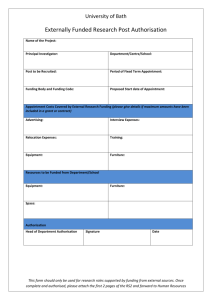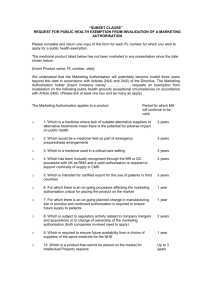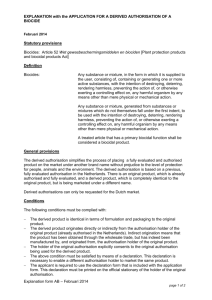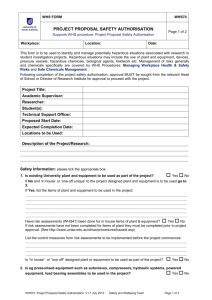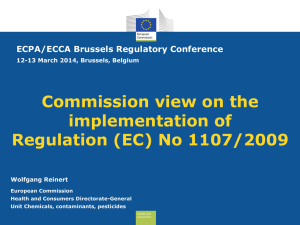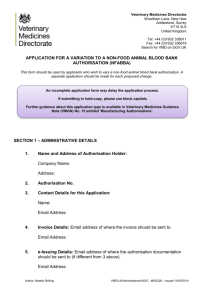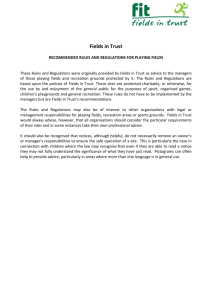Product Authorisation
advertisement
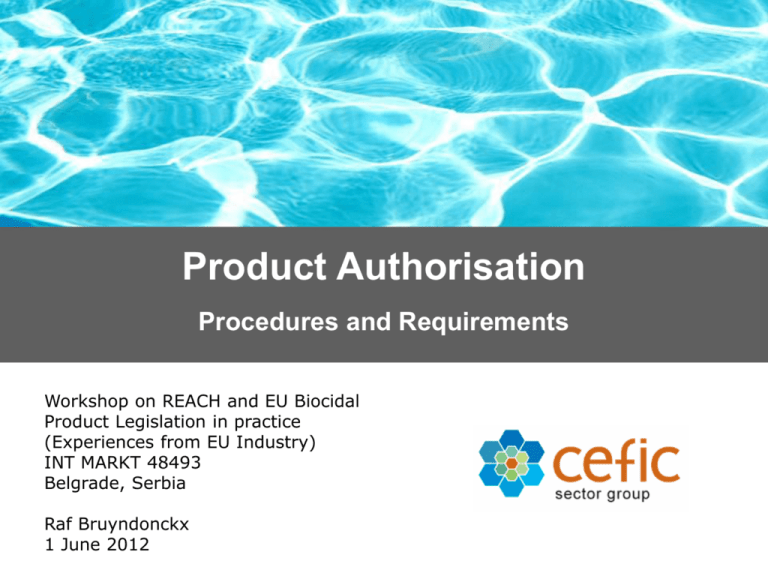
Product Authorisation Procedures and Requirements Workshop on REACH and EU Biocidal Product Legislation in practice (Experiences from EU Industry) INT MARKT 48493 Belgrade, Serbia Raf Bruyndonckx 1 June 2012 Outline • General principles • Procedures • Application • Data requirements • Fees • Role of industry associations 2 Cefic • Cefic – European Chemical Industry Council • Membership • 28 national chemical federations • > 600 companies • > 20 affiliated sector associations • Horizontal - vertical • EU Policy Centre: REACH, International trade, energy and climate change, HSE, logistics, R&I … • 104 Sector Groups 3 EBPF • European Biocidal Products Forum • Sector group of Cefic • Regulatory developments of EU biocides legislation • AS producers & BP formulators • 70 members: companies, associations, federations • Recognised stakeholder & observer • Implementation BPD: AS evaluation – BP authorisation • New Regulation 4 EBPF – European Biocidal Products Forum Advocacy Team General Assembly Communication Issues Team Data Sharing WG General Issues Product Authorisation WG Management Committee Sustainable Use WG Dietary RA ISG Disinfectants WG Sector-Specific Issues Insecticides WG RDDG Rodenticides WG Best Practice WG BPR - New era starting Sep 2013 • Updated EU biocides law applicable 1 Sep 2013 • Regulation – directly applicable to all EU • Same principles, improved procedures – mutual recognition, changes to products • New concepts – EU authorisation, product family • Extended scope – treated articles • European Chemicals Agency 6 Abbreviations • • • • • • • • • BPD BPR AS BP PT PA MR LoA MS Biocidal Product Directive 98/8/EC Biocidal Product Regulation active substance biocidal product product type product authorisation mutual recognition letter of access member state(s) 7 Product Authorisation General Principles 8 General principles • Authorisation is required before placing on the market • Authorisation is granted for max. 10 years • Authorisation can be granted if all conditions are fulfilled: • • • • • • AS is approved for relevant PT + AS source is on positive list The product is effective No unacceptable effects on target organism (resistance) No unacceptable effects on HH, ENV or animal health Chemical identity is known (impurities/residues) Phys-chem properties acceptable for transport and use 9 General principles • A BP cannot be authorised for use by general public if: • • • • • It is classified acute tox. (dermal, oral, inhalation); It is classified CMR 1 or 2; It has PBT properties; It has endocrine disrupting properties or It has developmental neurotoxic or immunotoxic effects 10 General principles • Dossier elements: • AS data: LoA or complete dossier • BP data: complete dossier (or LoA) • Assessment of hazard, risk (through relevant exposure) and efficacy • Draft Summary of the biocidal Product Characteristics (SPC) 11 SPC – the ID card of a BP • Trade name • Authorisation holder – authorisation number • Date of authorisation & expiry date • Manufacturer of BP and AS • Qualitative and quantitative composition • Type of formulation – categories of users • Instructions for use and safe disposal 12 Product Authorisation Procedures 13 Different procedures • (National) authorisation – provisional authorisation • Mutual recognition (in parallel or in sequence) BPR: • Union authorisation • Coordination by ECHA, evaluation by MS, decision by COM • Simplified authorisation procedure • Parallel trade authorisation • “Same product” authorisation 14 Timelines • 2 years to submit dossier • 2 years to grant, amend or withdraw authorisations • 3 months for completeness check • 12 months for first authorisation • 2 months to apply for mutual recognition • 4 months to recognise first authorisation • 3 months to resolve diverging opinions 15 Timelines 8/09/06 1/01/07 1/01/09 31/12/10 †No application/notification (30/06/09) †Failed completeness check (30/09/09) 3 months completeness check (01/01 to 31/03/09) 1st 12 months evaluation and authorisation (01/04/09 to 31/03/10) 2 months 4 months 3 application for recognition of months st mutual 1 authorisation (01/10 to recognition (01/06 to 30/09/10) 31/12/10) (01/04 to 16 31/05/10) Union authorisation - scope • Valid across all MS at once • Similar conditions of use across the Union - guidance • Excluded: Art 5 – PTs 14, 15, 17, 20 and 21 • Sep 2013: new AS - PTs 1, 3, 4, 5, 18 and 19 • Jan 2017: PTs 2, 6 and 13 • Jan 2020: all categories • Assessment report by 31 Dec 2017 17 Simplified authorisation procedure • Conditions: AS in Annex I (BPR), no SoC, no nano, no PPE, sufficiently efficient • No requirement for a LoA to AS dossier • Submission to the Agency • Evaluation by a MS within 90 days • Once authorised, notification to other MS is sufficient – no MR 18 “Same product” authorisations • Identical products • Existing practice (NL, FI, CH, SE, DK, PT, BE, IT ...) • Mutual recognition within a MS between companies • Faster procedures • Principle in BPR, follow-up regulation 19 Product Authorisation Application 20 R4BP • Register for Biocidal Products • Electronic database – “EU catalogue of products” • Application form – Applicant & product • Decision and assessment report BPR: • Electronic submissions – no more paper • Central communication and process management tool • Covers both AS and BP 21 R4BP 22 Product Authorisation Data requirements 23 General outline • Data on the active substance(s) – LoA to Annex I dossier • Substances of concern • Data on the biocidal product • Use description – exposure assessment • Analytical methods • Properties/Effect/hazard assessment (PC, TOX, ENV) • Risk assessment • Efficacy 24 CompleteDossier Dossier Summary D o s s i e r Doc. I Overall Summary 1) and Assessment Doc. II Risk and Efficacy Assess. Doc. II-C Risk Characterisation for Biocidal Product Doc II-A or LoA* Effects and exposure Ass. Active Subst.(s) 2) Doc II-B or LoA* - Effects Assess.** - Exposure Assess. - Efficacy Assess. Document III-A or LoA* Study Summaries 2) Active Substance(s) 1) To append: lists for Biocidal Document 2)III-B or LoA*: Prod.Summaries Study 2) Biocidal Product List of end points 2) To append: Reference List of abbreviations Check for completeness Doc. IV-A or LoA*: Test and Study Reports a.s.(s) Doc. IV-B or LoA*: Test and Study Reports b.p.** 25 Data waiving • A data requirement is not relevant to the product and/or the intended use • A study cannot be performed because the test is not feasible • The outcome of a study can be accurately predicted based on a scientific argumentation • The outcome of the study is in no way relevant to the risk assessment, classification and labelling or intended use 26 Principle approach • Collate info on components - AS and SoC • Start with detailed use description • Derive possible exposure (exclude specific routes) • Properties/Effect/hazard assessment • Risk assessment – Risk reduction measures • Efficacy 27 Availability of data • Active substance dossier (LoA required) • Co-formulants: REACH – MSDS • Public literature 28 Product Authorisation Fees 29 Fees • Broad variation across MS • First authorisation: 10.000 – 50.000 Euro • Changes: 500 – 25.000 Euro • Renewal: 500 – 50% of original fee • Annual fee: fixed or related to sales 30 Role of industry associations 31 Role of industry associations • General representation of industry • Endeavour to be recognised stakeholder • Consensus driven position taking • Competition law considerations • No specific role regarding data sharing 32 Useful sources of information • Note for guidance to applicants for PA and MR - link • EU Evaluation Manual - link • TNsG on data requirements – link • TNsG on product evaluation – link • Joint Research Centre – biocides section - link 33 Raf Bruyndonckx +32 2 676 7366 rbr@cefic.be
